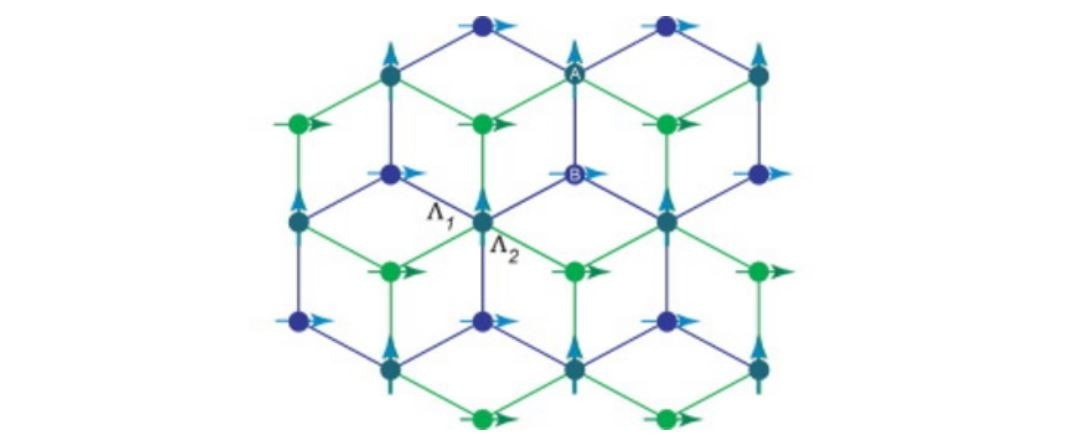A recent study published in the Science Bulletin details the use of a highly sensitive scanning superconducting quantum interference device (SQUID) microscope to investigate the behavior of the ferromagnetic material ABC-stacked CrBr3 in the absence of a magnetic field.

Bilayer CrBr_3 lattice forms an AB-stacking. CrBr_3 favors an easy-plane intralayer anisotropy (Λ_1 < 0), and a uniaxial interlayer anisotropy (Λ_2 > 0), which is effective only on ‘‘A” sites. When single-ion anisotropy is small and Λ_1+Λ_2~0, the spins are frustrated. ©Science China Press
Understanding the behavior of magnetic materials is a subject of great interest in materials science. In two-dimensional ferromagnets, the direction of the magnetic order is determined by anisotropy. However, when different anisotropies compete with one another, predicting the behavior of the material becomes very difficult.
Spin Correlation and Frustration in 2D Van der Waals Magnetic Systems
Scientists have been investigating spin correlation in real two-dimensional (2D) systems utilizing van der Waals magnetic materials. These materials have magnetic ground states that can be easily changed by altering the magnetic flux, pressure, or stacking orientation.
This modification directly affects the prevailing magnetic anisotropy between and within the layers, which is critical for 2D system order. In this regard, the Ising model often explores phase shift and sequencing in 2D magnets.
When two anisotropies from distinct sublattices compete with the same magnitude but opposite signs, they may cause frustration and phase change on a honeycomb lattice.
Researchers have looked to the van der Waals insulating chromium trihalide series to better understand these processes, which offers a typical localized spin structure on a honeycomb lattice.
Among such substances, single-crystalline CrBr3 stands out for its ability to sustain AB-stacking from bilayer to bulk and from low to room temperature. As a result, it is an ideal candidate for exploring spin correlations and related phenomena in 2D systems.
Scanning SQUID Magnetometry and Susceptometry
According to the fluctuation-dissipation theorem, the spin correlation in the aforementioned system can be probed by measuring magnetic susceptibility, which is directly related to the spin-spin correlation.
While volumetric techniques like neutron scattering are commonly used to study magnetic susceptibility in bulk materials, they do not apply to 2D materials. Optical magnetic microscopy, on the other hand, is sensitive to magnetization but cannot measure susceptibility, and external magnetic fields applied to enhance magnetization can alter the magnetic ground state and critical behavior.
To address these challenges, researchers have turned to scan SQUID (sSQUID) microscopy, a direct and sensitive imaging technique that can detect weak magnetic signals without the need for an external magnetic field.
This technique, especially when used with a nanofabricated SQUID equipped with a field coil, is suitable for performing local susceptometry by applying a modulating magnetic field and demodulating the flux signal for the AC susceptibility.
Methodology of the Current Study
To investigate the critical behavior of a ferromagnetic honeycomb lattice in CrBr3, the researchers used scanning superconducting quantum interference device microscopy (sSQUID) due to its high flux sensitivity. The spin correlations of ABC-stacked CrBr3 were probed under zero magnetic field conditions.
The study was carried out in two parts: the first part focused on identifying the unique signature of competing for intra- and inter-layer magnetic interactions in the bulk crystals of CrBr3.
The second part of the study examined the impact of these interactions in the 2D limit. A bilayer with interlayer interaction was compared side-by-side with a monolayer without any interlayer interaction, and 87 sSQUID images were obtained as a function of rising temperature from 13 to 40 K after zero-field cooling.
To understand the critical behavior of the bilayer, the researchers varied the layer number to examine how the susceptibility evolves from a higher lattice dimension. The obtained data were analyzed to determine the critical behavior of the ferromagnetic honeycomb lattice in CrBr3.
Important Developments of the Research
The study conducted by the researchers found that there is a 2D-3D crossover regime of constant short-range magnetic correlation above the critical temperature (TC) in thick CrBr3 samples.
This regime shrinks as the layer thickness is reduced, indicating a transition to the 2D universality class. The competition between intra- and inter-layer anisotropies was observed, which caused a spike and a plateau region in susceptibility as a function of temperature in the thick samples.
The methodology employed in this study holds the potential for studying spin frustration in 2D materials. The observation of frustrated ferromagnetic phase transition in AB-stacked bilayer CrBr3 demonstrates that susceptometry based on sSQUID can be used to study magnetic frustration in van der Waals materials.
Further research can be conducted to understand the transition mechanism from 3D to 2D and the role of the anisotropy competition in the magnetic frustration of 2D materials. The findings of this study are a significant step towards the development of new 2D materials with unique magnetic properties that can be used in various applications.
Reference
Wang, S. et al. (2022). Frustrated ferromagnetic transition in AB-stacked honeycomb bilayer. Science Bulletin. Available at: https://doi.org/10.1016/j.scib.2022.12.009
Disclaimer: The views expressed here are those of the author expressed in their private capacity and do not necessarily represent the views of AZoM.com Limited T/A AZoNetwork the owner and operator of this website. This disclaimer forms part of the Terms and conditions of use of this website.